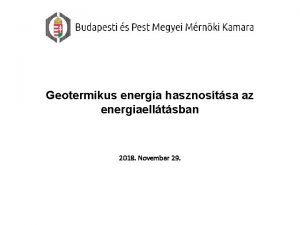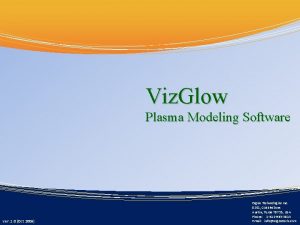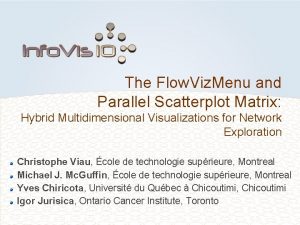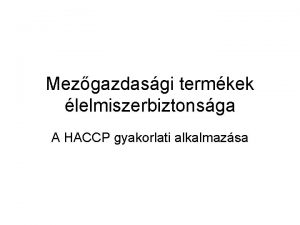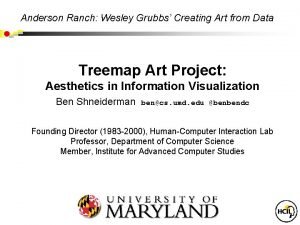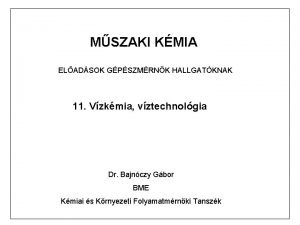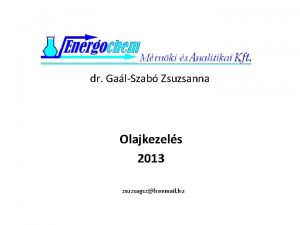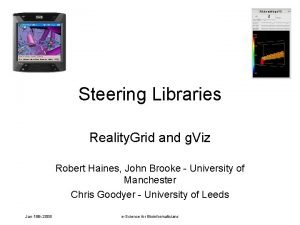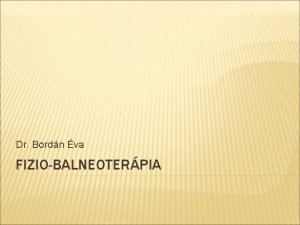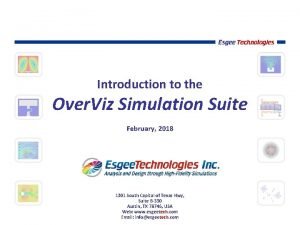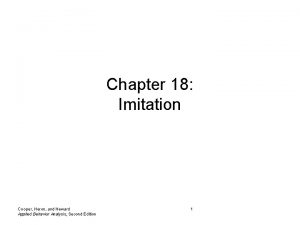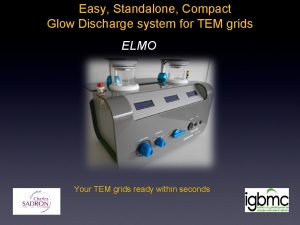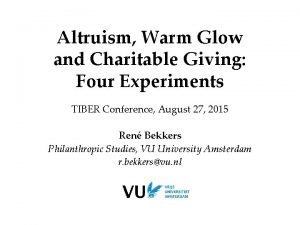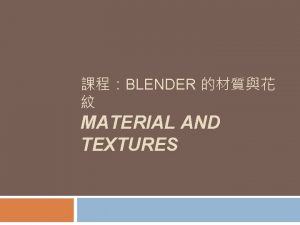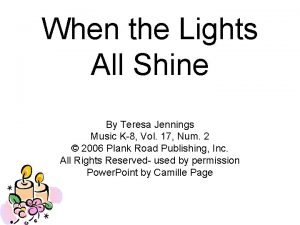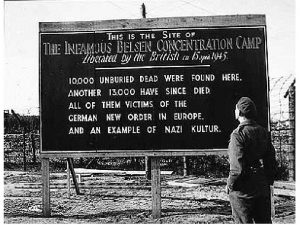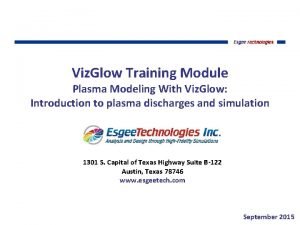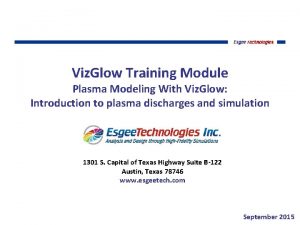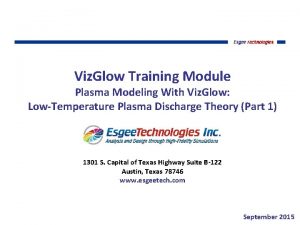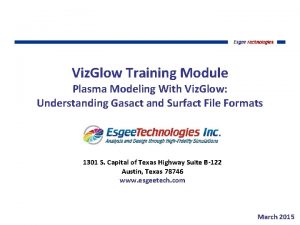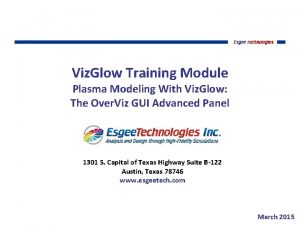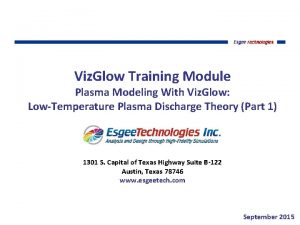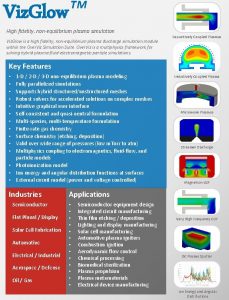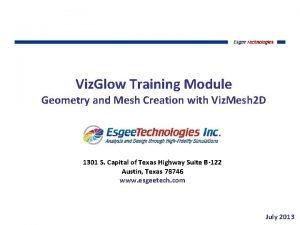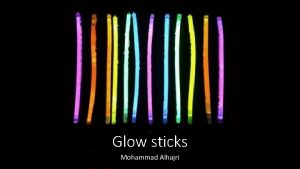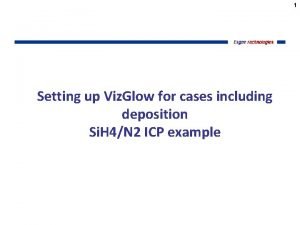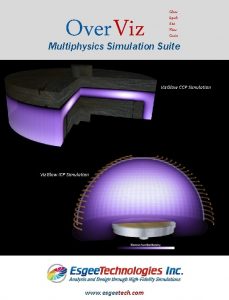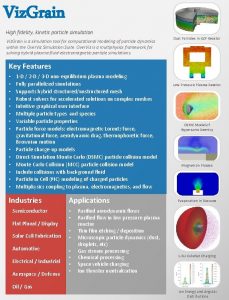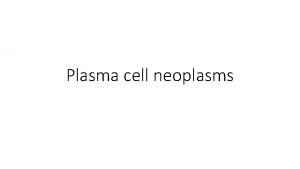Viz Glow Training Module Plasma Modeling With Viz






































- Slides: 38

Viz. Glow Training Module Plasma Modeling With Viz. Glow: Low-Temperature Plasma Discharge Theory (Part 2) 1301 S. Capital of Texas Highway Suite B-122 Austin, Texas 78746 www. esgeetech. com September 2015

2 COPYRIGHT AND CONFIDENTIALITY STATEMENT Copyright © (2007 -2015) Esgee Technologies, Inc. All rights reserved. This manual accompanies software that is provided to users under a license agreement. This manual can also be provided under a non-disclosure agreement and is subject to restrictions on confidential information under such an agreement. The manual contains proprietary information and may not be disclosed to a third party not covered by the license agreement or a non-disclosure agreement. No part of this manual may be reproduced in any form or by any means without express written permission from Esgee Technologies, Inc.

3 Sheaths

4 Sheaths §

5 Collisionless Sheath (low pressure) Bulk Plasma wall Number density Presheath Sheath Potential wall Un-driven (floating) sheath: no applied potential at the wall § Bulk Plasma : Quasi-neutral, negligible potential drop § Pre-sheath : Quasi-neutral, small potential drop (thickness ~ ion Debye length) § Sheath : Non-neutral, larger potential drop (thickness ~ few electron Debye lengths

6 Analysis of collisionless sheath: approximations § Electrons are in Boltzmann equilibrium § Constant electron temperature § No ionization in the sheath, ion continuity equation § Ions travel ballistically in the sheath (no collisions), energy conservation

7 Bohm sheath criterion § Bohm velocity

8 Potential drop in the bulk plasma § Zero ion velocity at center of plasma (symmetry), zero potential at sheath edge (assumed boundary condition) Potential at the center of the plasma with respect to the sheath edge for a collisionless sheath

9 Sheath potential at a floating wall § The ion flux in the sheath is (constant) § The electron flux at the wall is § Assuming no net current is carried to the wall by the plasma Potential at the wall with respect to the sheath edge for a collisionless sheath

Sheaths with applied voltage at the wall: Matrix sheath model (1/2) § 10

11 Matrix sheath model (2/2) § Matrix sheath thickness

12 Child law sheath model - collisionless (1/3) § The Child law sheath model accounts for the decrease in ion density in the sheath § Assumptions: § The applied voltage is much greater than the ion energy at the sheath edge, and § Ions travel in the sheath without collisions § Negligible electron density in the sheath § Conservation of energy and mass for ions § The ion density in the sheath can be expressed as

13 Child law sheath model – collisionless (2/3) § Potential in the sheath for Child’s law model

14 Child law sheath model – collisionless (3/3) § Child’s law (or Child-Langmuir law) for collisionless sheaths Child law sheath thickness

15 DC and Capacitive Discharges

16 Direct Current Discharges (DCD) § Ions accelerated in the sheath region towards the cathode surface § Excited species also diffuse towards the cathode surface § On impact, secondary electrons generated at cathode (Auger process) § Electrons are accelerated by the sheath electric fields reach the sheath edge resulting in electron impact excitation/ionization § Secondary electron emission processes are necessary to sustain discharge § Low-density plasmas (109 -1010 cm-3) E Potential +

17 Direct Current Discharges (DCD) – Vacuum breakdown (1/3) Sheath edge cathode § Electric field accelerates electrons located near the cathode to the edge of the sheath § The energetic electrons collide with neutrals and produce ions Ionization mean free path 0 § Ions travel towards the cathode, and emit more electrons at the surface due to secondary electron emission z=d § To satisfy charge continuity, Self-sustaining z

18 Direct Current Discharges (DCD) – Vacuum breakdown (2/3) Sheath edge cathode § The breakdown Electric field is the minimum value of the electric field required to produce a self-sustained plasma Breakdown voltage 0 z=d z § Breakdown condition in vacuum d First Townsend coefficient VB

Direct Current Discharges (DCD) – Vacuum breakdown (3/3) § The breakdown voltage in vacuum (Paschen’s Law) Breakdown voltage d VB Breakdown voltage (Paschen’s Law) 19

20 Capacitively Coupled Plasmas (CCP) (1/3) § potential E

21 Capacitively Coupled Plasmas (CCP) (2/3) § CCP discharge parameters § § Plasma density: (1015 -1017 m-3) Electron temperature: 1 -5 e. V Ion (Gas) temperature: 300 -1000 K Ionization Fraction: 10 -6 -10 -4 § For 1 -D, total current density in the plasma is a constant in space 1 -D

22 Capacitively Coupled Plasmas (CCP) (3/3) § For 1 -D, total current density in the plasma is a constant in space Conduction Displacement current density Conduction current density § The current density in the bulk plasma is mainly conduction current § The current density in the sheath is mainly displacement current

23 Magnetron CCPs (1/2) § Electrons trapped along field lines; improved hot electron confinement; improved uniformity § Stable plasma at very low pressures § Collapse of positive sheath structure with decrease in cross field electron mobility; § Loss of self-shielding effect; inverted sheath structure § Bulk plasma E fields are stronger because of sheath collapse § Increased resistivity of discharge (ions are important current carriers) B E no B field potential with B field

24 Magnetron CCPs (2/2) § Increased sensitivity to secondary electron emission on powered electrode § Increased confinement of ionization/excitation sources near powered electrode § Decreased dc negative bias when powered electrode has a blocking capacitor § Decrease in ion impact energies when B field is included Effect of magnetic field on the IEDF E B

25 Magnetron CCPs § Electrons trapped along field lines; improved hot electron confinement; improved uniformity § Decrease in cross field electron mobility; § Increased resistivity of discharge (ions are important current carriers) With magnetic field No magnetic field Hall parameter no B field potential E with B field B

26 EM waves and plasmas – ICPs, Microwaves

27 Inductively Coupled Plasmas (ICP) § RF coils generate EM field § Induced E field deposits power to electrons through collisional/stochastic heating § Power deposition within skin depth § Induced B field has no significant consequence on charge particle dynamics § Relatively high-density plasmas (1010 -1012 cm-3) B E

28 Microwave Plasmas (Radial line source) § Microwaves create a standing wave pattern in a dielectric wave plate § Antenna transmits radiation to window § Standing wave pattern also established in window § Electric fields penetrate region at the window-plasma chamber interface and heat electrons, generates plasma discharge § Over dense discharge region produces ions and radicals § Ions and radicals diffuse to the surface § Typical plasma density ~ 1011 -1012 cm-3 Microwaves Wave plate Window Plasma Radial line source Antenna

29 Plasma Conductivity § Electron momentum equation § Homogeneous density (neglect density and pressure gradients) § Phasor form: § Current density Plasma conductivity

30 Plasma Dielectric Constant § Total current density § Plasma dielectric constant

31 Collisionless regime (real dielectric) § Wave propagation is unhindered § (speed lower; wavelength shortening) (cut-off density) § Collisionless regime: (negative refractive index) § Wave propagation is attenuated § (skin depth)

32 Collisional regime Highly collisional regime: § Lossy material, wave attenuated § DC plasma conductivity (skin depth)

A simple model to study plasma-EM wave interaction effects • Linearly increasing electron density in z • Cutoff location Zo is varied • Critical density for 2. 45 GHz = 7. 5 e 16 m-3 • Assume pressure = 50 m. Torr • Regime: Collision freq. = 3. 5 e 7 #/s Excitation freq = 1. 54 e 10 rad/s (Nearly collisionless) Ref: Yasaka and Hojo, Physics of Plasmas, 7 (2000), 1601. 33

34 Field variation in plasma (inlet Ay = 1 e-7 V/m-s) -0. 1 to 0 m = dielectric (eps = 1. 0) 0 to 0. 5 m = plasma with linearly varying density Ne= Ne_critical * (x/Zo) Zo = 0. 2 m Computation domain: underdense overdense Zo = 0. 08 m dielectric overdense Zo = 0. 015 m dielectric overdense Ref: Yasaka and Hojo, Physics of Plasmas, 7 (2000), 1601. 34

35 Power deposition in plasma Zo = 0. 015 m (pressure = 50 m. Torr in argon) dielectric overdense dielectric Zo = 0. 08 m overdense dielectric overdense Zo = 0. 2 m dielectric underdense overdense 35

36 Effect of collisions (varying pressure) Plasma conductivity: P (Torr) Coll. Freq. (#/s) Real conductivity at cutoff density (S/m) Imaginary conductivity at cutoff density (S/m) 0. 05 3. 5 e 7 3. 1 e-4 -1. 36 e-1 0. 5 3. 5 e 8 3. 1 e-3 -1. 36 e-1 5 3. 5 e 9 2. 95 e-2 -1. 3 e-1 50 3. 5 e 10 5. 02 e-2 2. 21 e-2 Note: Excitation frequency =

37 Effect of collisions (Zo = 0. 015 m case) Location of cutoff density 50 m. Torr 500 m. Torr 50 Torr

End of presentation www. esgeetech. com
 Víz-víz hőszivattyú vízigénye
Víz-víz hőszivattyú vízigénye Plasma modeling software
Plasma modeling software Role modeling theory
Role modeling theory Relational modeling vs dimensional modeling
Relational modeling vs dimensional modeling Flow viz
Flow viz Tartósítási eljárások csoportosítása
Tartósítási eljárások csoportosítása Tenzió fogalma
Tenzió fogalma Fin viz map
Fin viz map A víz anomáliája
A víz anomáliája Víz vastalanítása
Víz vastalanítása Viz is neis
Viz is neis Durranógáz
Durranógáz Víz fázisdiagramja
Víz fázisdiagramja Virágos növények a vízben vízparton
Virágos növények a vízben vízparton G-viz
G-viz Hidroszféra részei
Hidroszféra részei Antiphlogistin pakolás
Antiphlogistin pakolás Viz online suite
Viz online suite Koenzimek
Koenzimek Esgee technologies
Esgee technologies C device module module 1
C device module module 1 Modeling and imitation training aba
Modeling and imitation training aba Kentucky glow caverns
Kentucky glow caverns Health and glow turnover
Health and glow turnover Glow sticks of steel
Glow sticks of steel Green glass globes glow greenly
Green glass globes glow greenly Glow discharge system
Glow discharge system Warm glow altruism
Warm glow altruism Darvel primary school glow
Darvel primary school glow Minipcr dna glow lab answers
Minipcr dna glow lab answers The emigree by carol rumens
The emigree by carol rumens She walks in beauty analysis
She walks in beauty analysis Glow stick lab
Glow stick lab Echinops bannaticus the giant
Echinops bannaticus the giant Blender glow texture
Blender glow texture Kamoteng kahoy go grow glow
Kamoteng kahoy go grow glow She lit a candle in new orleans
She lit a candle in new orleans Tiny glow worm tenderness
Tiny glow worm tenderness Glow stick light painting
Glow stick light painting
